Introduction to the Greek Alphabet
The Greek Alphabet has 24 letters. The letters have an upper and lower case versions. Modern Greek is written from left to right.
This page will teach you the Greek letters. To learn to write the letters and memorise them, we suggest using our Greek Letters app.
Greek Letters are a favourite of scientists to represent things.
Many ancient texts can be found written in Greek.
Over 12 million people speak Greek.
The letters of the alphabet are:
| Capital | Lower case | Sounds | ||
| 1 | Alpha (άλφα) |
Α | α | a |
| 2 | Beta (βήτα) |
Β | β | b, v |
| 3 | Gamma (γάμμα) |
Γ | γ | g, gh, y, ng |
| 4 | Delta (δέλτα) |
Δ | δ | d, th |
| 5 | Epsilon (έψιλον) |
Ε | ε | e |
| 6 | Zeta (ζήτα) |
Ζ | ζ | z, ds, sd |
| 7 | Eta (ήτα) |
Η | η | e, i |
| 8 | Theta (θήτα) |
Θ | θ | t, th |
| 9 | Iota (ιώτα) |
Ι | ι | i |
| 10 | Kappa (κάππα) |
Κ | κ | k |
| 11 | Lambda (λάμβδα) |
Λ | λ | l |
| 12 | Mu (μυ) |
Μ | μ | m |
| 13 | Nu (νυ) |
Ν | ν | n |
| 14 | Xi (ξι) |
Ξ | ξ | x, ks |
| 15 | Omicron (όμικρον) |
Ο | ο | o |
| 16 | Pi (πι) |
Π | π | p |
| 17 | Rho (ρώ) |
Ρ | ρ | r |
| 18 | Sigma (σίγμα) |
Σ | σ | s |
| 19 | Tau (ταυ) |
Τ | τ | t |
| 20 | Upsilon (ύψιλον) |
Υ | υ | u, i |
| 21 | Phi (ιώτα) |
Φ | φ | p, ph, f |
| 22 | Chi (φι) |
Χ | χ | c, ch, h |
| 23 | Psi (ψι) |
Ψ | ψ | ps |
| 24 | Omega (ωμέγα) |
Ω | ω | o, aw |
The first two letters, Alpha and Beta are the origin of the word alphabet
Greek is one of many alphabets derived from the Phoenician alphabet. The Roman/Latin alphabet was derived from the Greek alphabet, and the English alphabet was subsequently derived from the Roman/Latin alphabet. As such, you will find many similarities in the character shapes and sounds to English.
Of the 24 capital letters, 13 are written the same as English letters.
There are 7 vowels in the Greek alphabet, These are Α α, Ε ε, Η η, Ι ι, Ο ο, Υ υ and Ω ω. Whilst in ancient Greek, the 7 vowels would have had distinct sounds, some of them have now merged.
Both Omicron and Omega make the 'o' sound but differ in the length of the 'o' sound. The clue to the length is in the names, O - Micron, and O - Mega. Thus micron for the short o sound and mega for the long o sound.
Pronunciation
The sounds in the above table are the approximate sound equivalents in English. Some letters of modern Greek sound different compared to ancient Greek. Not all letters an be represented accurately from an English equivalent sound. In addition some of the letters, such as gamma can change pronounciation depending on the letter positioning within a word. The sounds given above are supplied only for indication.
There are predominantly 3 ways to pronounce Greek, the modern way (as spoken by Greek people today), the ancient way (as spoken by those studying ancient Greek texts), and the science way (as spoken by scientists, mathematicians, etc. when they use the Greek letters).
All methods are correct within their intended use areas and there is much overlap in pronunciation.
If you learn the modern pronunciation as spoken by Greek's today, you will
see how science(and/or the English language) has propagated incorrect pronunciation of some of the Greek letter sounds.
A few pronunciation variations:
Beta - As with many languages, the b and v sounds overlap, with ancient Greek leaning more towards the b sound and modern Greek towards the v sound.
Delta - Sounds like 'th' in modern Greek.
Gamma - In modern Greek, gamma takes a 'g' sound before a, o, u or consonants, but takes a 'y' sound before e or i vowels.
Mu - The letter name is usually said as 'moo/myu' in scientific circles, but sounds like 'mi/mee' in modern Greek.
Rho - The letter is trilled much like the Spanish 'r'. English doesn't have the trilled r sound, so you will often hear rho spoken without the trill.
Tau - The letter name sounds more like 'tough' in modern Greek.
Final Sigma
In a similar way to how some Hebrew letters have final forms, the lower case sigma has a different form when written at the end of a word.
| Capital | Lower case | Lower case final |
|---|---|---|
| Σ | σ | ς |
Example:
έτος means year in Greek and ends with a sigma. Since the sigma is at the end of the word, the final form is used.
τσάι means tea in Greek, it has a sigma, but it is not at the end so the normal lower case form is used.
Greek Letters in Science
Greek letters have been used extensively in science to represent various things,: measurands, units, constants, quantities & particles. Greek letters stand out as different and make reading of scientific literature clearer. Greek letters are often used consistently to represent the same thing across the wider scientific community. For example the uppercase sigma, Σ, is used for summations, and is used without the necessity of explaining it's meaning each time. Greek letters can be called upon to represent any quantity in algebraic expressions as and when they are needed, with the choice of letter often guided by the field of research, but otherwise by the writers preference. The following table lists just a few of uses of the Greek letters used in science and mathematics.| Letter | Symbol | Uses |
|---|---|---|
| Alpha | α | Alpha Radiation - α particles (2 protons and 2 neutrons) are a form of radiation that travels a few cm and can be stopped with a piece of paper. |
| Used to represent angular acceleration in physics. | ||
| α is often used to represent angles in mathematics. | Beta | β | Beta radiation (unbound electrons), are a form of radiation that can travel a few meters in air. |
| Gamma | γ | Gamma rays/radiation (high energy photons). |
| In special relativity, γ is the Lorentz factor, which describes how time slows down and dimensions change near the speed of light. | ||
| Delta | δ | Used in science/mathematics to represent a small change for calculus purposes. |
| Epsilon | ε | ε represents the emissivity of a material. That is the amount of radiation emitted compared to a black body of the same temperature. |
| In electromagnetism, ε is used for to represent the permittivity. | ||
| In electronics, ε is used for the electromotive force (emf). | ||
| Eta | η | Used to represent Energy efficiency. |
| Theta | θ | Commonly used to represent angles. |
| Lamda | λ | Used to represent wavelength. |
| Used to represent decay rates. | ||
| Mu | μ | Called 'micro' when representing one millionth of a unit. E.g. 1 μm, one micrometer is one millionth of a meter |
| In statistics, μ represents the population mean. | ||
| In electromagnetics, μ represents the permeability. | ||
| Nu | ν | Often used in physics to represent frequency. |
| ν is the symbol used for neutrinos. | ||
| Pi | π | In, mathematics, π=3.1415927.... |
| Rho | ρ | Used to represent density. |
| In electronics ρ is used for resistivity. | ||
| Sigma | σ | Used to represent stress in mechanics. |
| In statistics σ is used for standard deviation. | ||
| In electronics σ is used for conductivity (the reciprocal of resistivity). | ||
| Σ | In mathematics, Σ is used to to indicate a summation. | |
| Tau | τ | Used to represent torque in mechanics. |
| τ is used for the time constant, the time to fall to 1/e or ~36.8% from an initial value, or rise to 63.2% of its final value. | ||
| Phi | φ | Used to represent flux. |
| φ is used for an angle in spherical and cylindrical coordinates. | ||
| Psi | ψ | In quantum mechanics, Psi is found in the Schrödinger equation. |
| Omega | ω | ω is used to represent angular velocity. |
| Ω | In electronics, Ω is used to for the unit of resistance. |
When used in science, sometimes the Greek letters are made to look less like English letters to avoid confusion. For example, Alpha is commonly written identical to the English 'a' in Greek, but will be exclusively more like a fish looking left in science. The Letter Nu (ν) is usually written like a 'v' in Greek, but will typically be curved slightly when used in science. Similarly for other letters a curve may be emphasised when used in science.
Note that he Lower case Beta looks much like the German Ezsett, ß, character. Don't get them confused, emphasise the tail a bit more if you need to in writing, or make sure to use the correct character code especially if you are composing scientific articles.
Stroke Order for Lower Case Letters
Whilst some of the Greek letters are consistently written the same, there is some variation in others. Emphasis is on legibility and not stroke order, so no need to relearn how to write a letter. For example, if you already can write in English, you already know 13 of the Greek capital letters and a few of the lowercase ones too. When handwriting in Greek, the letters can often look like English letters. (for example α can look like a, η can look like n, ν can look like v). When Greek letters are used within scientific or inside English texts, emphasis should be on forms that are not confusable with English letters.Some of the characters will extend below the line (β, γ, ζ, η, μ, ξ, ρ, φ, χ, ψ and ς ). However, sometimes β, η and ς are written not extending below the line.
6 of the characters will extend higher than the others (β, δ, ζ, θ, λ and ξ). And sometimes the central line in φ and ψ is also written to extend higher.
The stoke orders for the lower case Greek letters are below :

Alpha

Beta

Gamma

Delta

Epsilon

Zeta

Eta
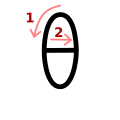
Theta

Iota
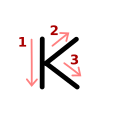
Kappa
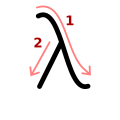
Lambda
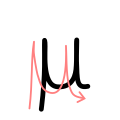
Mu

Nu

Xi

Omicron
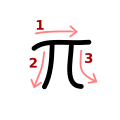
Pi

Rho

Sigma

Final Sigma
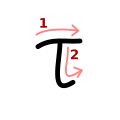
Tau

Upsilon

Phi
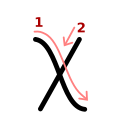
Chi
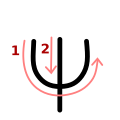
Psi

Omega
Notable variations
Alpha - Often written like the letter a in English. Occasionally written by drawing the letter o and merging it with a narrow c.
Beta - Beta is sometimes written with one stroke starting in the middle and looping around omitting the tail. (see image below)
Delta - The final hook is often done by reversing pen direction into a short horizontal. (see image below)
Zeta - The horizontal top of the stroke is often curved or looped. (see image below)
Eta - Sometimes the tail is omitted leaving it looking like the English 'n'.
Theta - Often written as one stroke. (see image below)
Kappa - The first two strokes are often combined, resulting in a kappa that is more distinguishable from the English 'K'. (see image below)
Mu - Sometimes drawn in two steps, first an English 'u' and then the downstroke on the left side.
Nu - Often drawn with straight lines to like an English 'v'.
Xi - The horizontal top of the stroke is often curved or looped as with Zeta. (see image below)
Pi - Pi is sometimes written as one stroke to form 3 sides of a box. (see image below)
Rho - Sometimes written in reverse with the loop first.
Sigma - Sometimes written by starting at the top, drawing the circle and then reversing direction for the tail.
Final Sigma - Sometimes written like the English 's'.
Phi - Sometimes written like the capital Phi by first drawing the circle and then drawing a line through it.
Xi - Sometimes written with straight lines.
Some common lower case variations:

Beta

Delta

Zeta

Theta
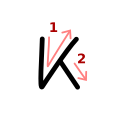
Kappa

Xi

Pi
Stroke Order for Upper Case Letters
13 of the Greek uppercase letters, are identical to letters found in the English alphabet, so you can likely already write them.
Omega has two forms. It can look like the symbol for electrical resistance, or it can be written as a circle with a line drawn underneath. The first version tends to be used more in print and the circle with a line underneath used more in handwriting.
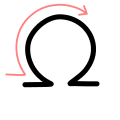
Omega
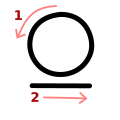
also Omega
The uppercase Pi, just like its lowercase counterpart can be written in two ways.
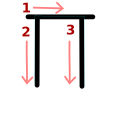
Pi

also Pi
The stroke orders for the other uppercase Greek letters is on the next page.
